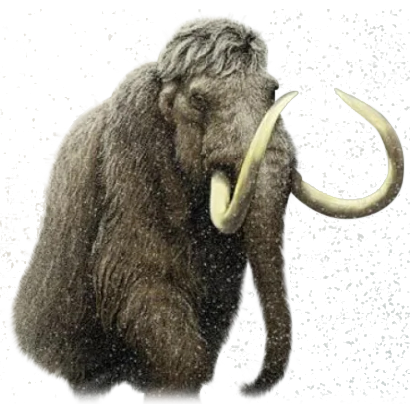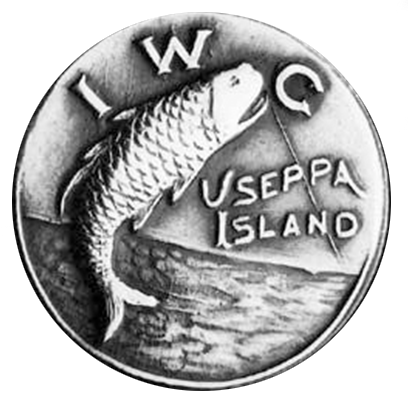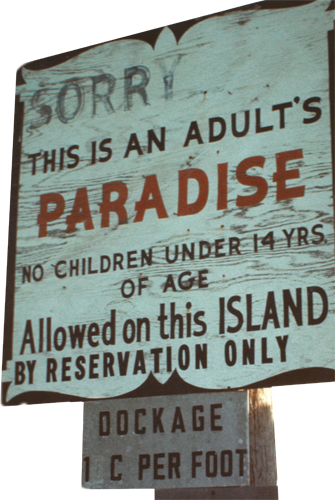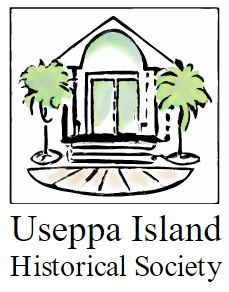Useppa Island Historical Society
Explore our timeline! Start by picking a time range:
Date Range: 8000 B.C – 500 B.C

ca. 8000 B.C.
Landform that would later become Useppa Island is visited by Paleo-Indian people.
ca. 4500 B.C.
Rising sea level makes Useppa an island; oyster-shell middens begin to be deposited on the ancient dune sands by seasonal inhabitants; estuarine environment approaches conditions similar to those of today.
ca. 4000-3000 B.C.
Barrier islands form to create Pine Island Sound.
4500-3000 B.C.
Calusa Ridge is occupied, mostly during the spring and summer. As estuarine conditions become more pronounced, catfish, pinfish, pigfish, rays, sharks, other fish, oysters, whelks, conchs, and clams are eaten; at first, pine is used for firewood, then later mangroves, seagrape, and buttonwood are selected, as the estuary becomes more firmly developed; seeds and fruits of seasonally available plants are consumed; columellae of lightning whelks are worked into hammers and cutting-edged tools; shouldered celts made of lightning whelks show close connection to Horr’s Island; other shell artifacts include quahog clam shell anvils, net mesh gauges, and notched bivalves; bone-engraving artistry similar to that of other contemporary people elsewhere in the Florida peninsula shows evidence of wide-ranging communication and exchange of ideas; bone points are also made; chert from near Tampa is used to make bifacial stone tools.
3000-2000 B.C.
Calusa Ridge and Collier Ridge are occupied, mostly in the spring and summer months. Catfish, pinfish, pigfish, rays, sharks, other fish, oysters, whelks, conchs, and clams are eaten; firewood used is a mixture of pine, mangrove, and other woods; seeds and fruits of seasonally available plants are consumed; columellae of lightning whelks are worked into hammers and cutting-edged tools; shouldered celts are made; quahog clam-shell anvils are used; chert from near Tampa is used to make tools; the dead are buried in flexed position in middens in both Collier and Calusa Ridges.
2000-1200 B.C
Steatite stone vessels and fiber-tempered pottery of the Orange series are used on Useppa Island; Sand-tempered pottery is used by 1200 B.C.; Calusa Ridge is abandoned, but Collier Ridge continues to be occupied, mostly in the spring and summer months (March-August). Diet continues to be catfish, pinfish, pigfish, sharks, rays, other fishes, and shellfish, supplemented by wild plant foods.
1200-500 B.C
Terminal Archaic occupation is limited to Collier Ridge and the south-central area (east of Calusa Ridge and west of the southeastern midden ridge), mostly in the spring and summer months (March-September). Diet continues as before, but with less emphasis on sharks and rays. Pottery is sand-tempered plain ware.
500 B.C. - A.D. 500
Extensive Caloosahatchee I-period occupation is located in the southeastern ridge area (Milanich and Chapman’s Tests 3 and 5) and the south-central area (the area east of Calusa Ridge and west of the southeastern ridge) in the summer and fall months (June-October). Diet continues to be catfish, pinfish, pigfish, sharks and rays, other fishes, and shellfish, supplemented by wild plant foods; evidence of occupation includes substantial middens ca. A.D. 400-500 in areas of Test Pit I-3, Operation D, (area of Lot II-11), and Milanich and Chapman’s Test 6. Pottery is mostly thick, sand-tempered plain ware.
500 A.D. - 800
During the Caloosahatchee IIA period, Collier Ridge and Calusa Ridge are used for burial ca. A.D. 600-800; Belle Glade pottery is used by ca. A.D. 600; broken pottery is deposited with burials in Collier Ridge; occupation of south-central area diminishes, but southeastern ridge accumulates rapidly after A.D. 700, with evidence of more diverse and higher salinity shellfish than previously deposited. The food assemblage includes wild plants, fish, sea urchins, penshells, surf clams, fighting conchs, oysters, scallops, and various other whelks and conchs.
Date Range: 800 – 1855
A.D. 800-1200
During the Caloosahatchee IIB period, the southeastern ridge continues to grow rapidly, with evidence of high salinity shellfish. Diverse food assemblage includes wild plants, fish, sea urchins, penshells, surf clams, fighting conchs, oysters, scallops, and various other whelks and conchs.
A.D. 1200-1700
No known habitation of Useppa Island; possibly used sporadically as a fishing camp.
1704-1750
Effective end of domination of the area by Calusa Indians; most native south Florida Indians succumb to slavery, warfare, and disease; Yamassee and Uchise (Creek) people enter Florida from the north, bearing firearms; Yamassee are bent on enslaving south Florida people for service in the Carolina colony; Uchise claim some former Calusa territory.
ca. 1780's
Muspa Indians are reported to be living on Captiva, Sanibel, and other nearby Islands. The Muspa may be descended from people who formerly occupied the Ten Thousand Islands area, possibly mixed with remnants of Calusa and other native groups.
ca. 1784
Cuban Jose Caldez begins to use Useppa as a seasonal location for mullet fishing, employing both Cuban and Native American laborers (probably a mixture of native southwest Florida people–Muspa/Calusa (?)–and refugees from northern Florida missions and in-migrating Creek people). The name “Seminoles,” derived from the Spanish word “cimarrones” for wild or untamed, begins to be applied loosely to all Indian people in the Florida peninsula.
1831
Useppa is listed as “Caldez Island” in William Whitehead’s inventory of fishing rancho operations.
1832
George C. Willis is assigned to “Josefa” Island as a customs official; he builds a house on the north end of the island; Caldez is still living on the island.
1833
John Lee Williams refers to the island as “Toampe,” reporting that Caldez has a village of almost 20 palmetto houses on the southwest point of the island. About 60 people, Europeans and Indians live on the island.
Henry Crews replaces Willis as customs official. Caldez sells island to Joseph Ximenez for $372.
1835
Second Seminole War begins over Indian Removal issue; so called “Spanish Indians” who work in the fishing industry on Useppa and elsewhere – even those married to Cubans – are in danger of capture and removal. Caldez sails from Useppa Island to Havana for probably the last time; the name of his schooner is registered as the “Joseffa”.
1836
Henry Crews is killed, ostensibly by Indians; fishing ranchos on Useppa and other places are burned by American soldiers, who fear they are being used by Indian sympathizers; Crews’s replacement Alexander Patterson reports that there is “no living person in Charlotte Harbor.”
1848 - 1855
1848-1855 U.S. Coast Survey of Charlotte Harbor produces “Sketch F” map showing “Ft. Casey” on Useppa Island (Bache 1855).
1850 A supply depot on Calusa Ridge called Fort Casey is established on January 3, 1850, garrisoned by 108 men; it is abandoned on November 10th of the same year.
Date Range: 1850 – 1950
1859-1863
Topographic and hydrological survey of area results in navigation chart (Bache 1863); island’s name is printed on a map as “Useppa” for the first time.
1863: Union soldiers camp on Useppa Island during the War between the States; Charlotte Harbor is blockaded to try to prevent beef shipments to the Confederacy; the surrounding area is inhabited sparsely by hunters, fishers, and farmers. Union sympathizers find refuge on Useppa Island under the protection of the Union army. Some are active as Florida Rangers.
1870
Census reports two persons living on “Giuseppe Island.”
1875
Physician and writer Charles Kenworthy refers to “Useppi” as one of three places in the immediate area at which to obtain fresh water.
1882
M. H. Simons of the Smithsonian Institution visits the island, referring to it as “Useppa Key.” He notes that Useppa was used by “Spanish fishermen” as a source of water, but says that there is little habitation in Charlotte Harbor.
1885
Andrew Douglas reports that Useppa Island is “desolate and uninhabited,” and that no more than ten adults live in the entire Charlotte Harbor area.
1895
1895(?) Useppa Island is purchased by A.M. McGregor.
1895 Eleanor Pearse and her family visit Useppa in February; she reports one Cuban family in residence.
1896-1898
John Roach buys Useppa Island, builds home and hotel.
1899
Sixteen-foot windmill and 35,000-gallon water tank are built on Useppa for irrigating groves and flower gardens.
1900 - 1902
1900 Archaeologist Clarence B. Moore visits “Joseffa” Island but does not excavate there.
1902 Izaak Walton Club is founded on Useppa Island.

1907 - 1918
About 1907 Name of hotel is changed from “Useppa Inn” to “Tarpon Inn.”
1911 Useppa Island is purchased by Barron Collier.
1914 Shells are brought from Captiva Island to build a road connecting the hotel, barn, and bungalows.
1915 Work begins on the golf course, June 15, 1915. More than 100 cords of oak wood are obtained from the clearing operations. Another shell road is built from the tennis courts to the south end of the island. Laundry and refrigeration plant are constructed.
1916 The nine-hole golf course opens for play. Fifteen to twenty tarpon fishing guides are employed by Useppa.
1917-1918 The hotel is enlarged and remodeled by Collier; a third floor is added, a colonial-style porch and entrance are built.
1918-1939
1918-1939 Useppa is a popular seasonal destination for the wealthy; Useppa Island becomes Barron Collier’s official residence as he builds a broad-based development, transportation, resort, and communication business. By the late 1930’s, Collier owns more than 1,000,000 acres of land in Florida.
1926 Five of the stilt houses built for guides are blown away by a hurricane, September, 1926.
1927 or 1928 The hotel’s name is changed from “Tarpon Inn” back to “Useppa Inn.”
1939 – Barron Collier dies March 13, 1939 at the age of 65.
1941-1945
Useppa Island is closed for business during World War II.
1944-1947
The Useppa Inn and other buildings are damaged by hurricanes of October 20, 1944 and October 7-9, 1946.
The hotel is demolished in the late 1940’s.
1947 - 1960
1947-1960 The Collier family operates Useppa Island as a seasonal resort.
1947 Archaeologists John Griffin and Hale Smith visit Useppa to examine middens and burials disturbed by tennis court construction (Griffin and Smith 1947; Griffin 1949).
1951 Useppa is recorded in the Florida archaeological site file by J. M. Goggin
1960 The Central Intelligence Agency uses Useppa for secret training of officers for planned Cuban invasion.
Date Range: 1960 – Present

1962
William A. Snow purchases Useppa Island; refurbishes buildings, installs pool, septic system, and air strip.
1966
Useppa Island sustains damages from Hurricane Alma, October 1966. The island is put up for sale by Snow.
1968
Jimmy B. Turner purchases Useppa Island; builds new docks; operates the island as year-round resort for the first time; no children under 14 are permitted on the island.
1970
Useppa Island closes.
1973
Mariner Properties Development Corporation purchases Useppa from Turner, but does not develop it.
1976
Garfield Beckstead (Useppa Inn and Dock Company) purchases Useppa from Mariner.
1979
Jerald Milanich and Jefferson Chapman undertake archaeological backhoe tests.
1980 - 1985
1980 Milanich and Chapman do test excavations.
1981 Cable connects Useppa Island to electrical power from the mainland.
1984 Milanich et al.’s (1984) report is published.
1985 William Marquardt and Michael Hansinger perform salvage excavations at Collier Ridge (Operation A).
1989
Marquardt and Corbett Torrence excavate on Calusa Ridge (Operations B and C), Lot II-11 (Operation D), and the southeastern shell ridge (Operation E), “Year of the Indian” project.
1992
Results of 1985 archaeological excavations are published (Marquardt 1992b). 1993 Marquardt and Maria Palov excavate in search of intact historic-period middens (Operations F-I).
1994
Useppa Museum opens, April 2, 1994. Its “Calusa Room” exhibits findings from Florida Museum of Natural History investigations of 1985 and 1989.
Marquardt does salvage excavation of burial, Lot II-17.
1995 - 2000
1995 Karen Walker submits nomination of pre-columbian components to National Register of Historic Places. Jenna Wallace studies burial from Lot II-17 (Marquardt and Wallace 1995).
1995 Marquardt interviews Beckstead, researches golf-course topography.
1996 Useppa Island’s pre-columbian components are listed in the National Register of Historic Places. Walker conducts test excavations in the twentieth-century midden (Operation J). Useppa Island observes it “Centennial,” marking 100 years since John Roach began to entertain guests in his island home. Renovations to Collier Inn are begun.
1996 Renovations to Collier Inn are completed; new roof line more closely approximates original appearance; rooms are again offered for rent, making it a true inn once again. Development begins on final phase of lots on the island – those on the extreme southern end, site of the former airstrip. Walker undertakes new excavations in the southeastern midden ridge area to investigate climatic fluctuations during the Caloosahatchee IIB period. All chapters of this monograph are completed and prepared for publication.
1999 The Archaeology of Useppa Island is published.
2000 - Present
2002 The Useppa Museum is renamed to The Barbara Sumwalt Museum.
2004 Useppa gets a direct hit from Hurricane Charley, a category 4 hurricane, on Friday, August 13th and suffers enormous damage to the structures and foliage on the island.
2004 The island recovers from the hurricane, the Collier Inn and homes are rebuilt and Useppa undergoes extensive re-landscaping.
2005 The Collier Inn has a grand reopening on August 13, one year to the day after being damaged by Hurricane Charley.

© 2020 Useppa Island Historical Society
Support
Exhibits
Join our Email List